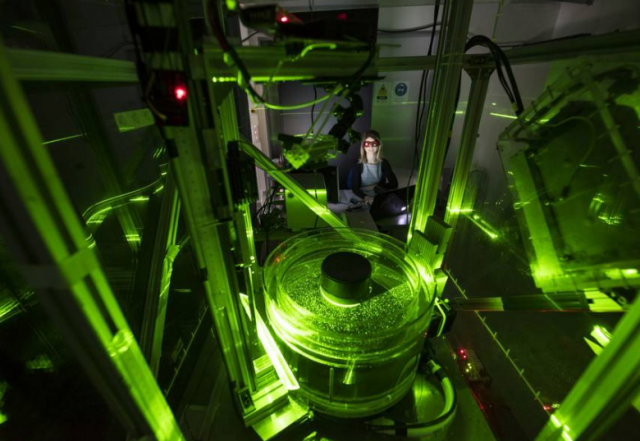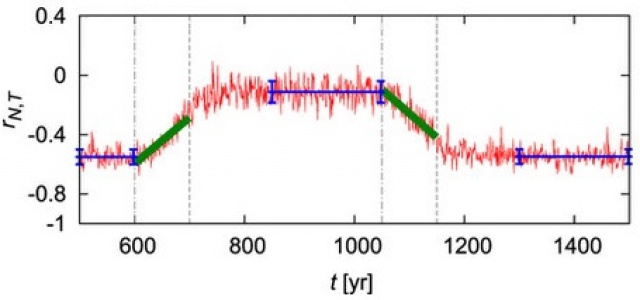Changes in temperate climate demonstrated on a laboratory table by MTA and ELTE physicists
Although the climatic history of the Earth is a linear course of events, model experiments can reproduce this development multiple times. Scholars at the MTA-ELTE Theoretical Physics Research Group have explored the statistical properties of climate change from a physical perspective. The results show that numerous climate histories can result from almost identical sets of conditions.
13 April, 2017
The international scientific community is showing growing interest in the physical analysis of the statistical properties regarding climate change. Two scientific articles written by the MTA-ELTE Theoretical Physics Research Group have been published in Nature and its affiliated journal, Scientific Reports. The two studies are complementary, as one focuses on experiments, while the other discusses theoretical and numerical results, applying the same approach.
Air currents on the laboratory table
Miklós Vincze, a member of the research group, and his two colleagues from the Cottbus Brandenburg University of Technology (BTU) have modeled the course of climate change in a laboratory for the first time in the world. The modeling is possible due to hydrodynamic similarity. Owing to this principle, large-scale air currents comparable to the Earth’s currents can be modelled in containers the size of a table if the parameters are set correctly. Based on such experiments, it can be stated that a convection driven by a lateral temperature contrast in a shallow fluid layer is a surprisingly good model of the climate system in the temperate zone.
 A rotating container used for climate experiments. The water layer that models the atmosphere at temperate climates is to be found between the inner heated and outer cooled cylinders. Source: Brandenburg University of Technology, Cottbus-Senftenberg
A rotating container used for climate experiments. The water layer that models the atmosphere at temperate climates is to be found between the inner heated and outer cooled cylinders. Source: Brandenburg University of Technology, Cottbus-SenftenbergResearch conducted at the von Kármán Laboratory for Environmental Flows at the ELTE Institute of Physics and at the Department of Aerodynamics and Fluid Mechanics at BTU focused on how the slow, “climate-change-like” changes of temperature conditions driving the convections in the experimental system modify the changeability of modelled weather. In such a constantly evolving system, appropriate statistics can only be obtained if we collect an average over a multitude of several realisations with the same time-dependent climatic forcing. In practice, this meant that the temperature at the “polar regions” of the atmospheric model was gradually increased, that is, the contrast between the “polar region” and the “equator” was diminished.
The experiments proved that with a given force, the produced temporal scales differed significantly. This experience warns us that climate prognoses should be handled cautiously, as the climate of the Earth is only one possible realisation, and as such, is not representative. The results proved that a correct description of experimental climate change was produced by ensemble averaging over a multitude of data and provided the possible fluctuations.
Parallel climates
Mátyás Herein and his colleagues have advocated the need for an analysis of parallel earthly climates based on the theory of snapshot attractors. In short, we should imagine an ensemble of several copies of the Earth system moving on different hydrodynamical courses, following the same physical laws and boundary conditions. These boundary conditions, such as the CO2 content of the atmosphere, might change over time; however, these changes are the same in all copies. (their study is available here)
The ensemble of parallel climate realisations depicts possible climate histories. From a scientific point of view, a reliable prediction for a future moment is if a typical behaviour is selected and the nature of the fluctuation is also presented. It is easy to see the connection with the experimental study: Miklós Vincze’s experiments followed the parallel laboratory climate realisations alongside environmental parameters, which changed in the same way.
Long distance atmospheric interactions were also studied
Mátyás Herein and his team examined parallel runs in a large-scale climate model called Planet Simulator in order to provide a correct statistical description of atmospheric teleconnections in the case of climate change. A surprising property of the Earth system is that a change at a certain location might produce dramatic changes in places extremely far away. The best known such teleconnection is related to the El Niño phenomenon.
The authors examined the North Atlantic Oscillation (NOA), which has a much more significant effect on Europe. In winter, a permanent high-pressure system over the Azores and a permanent low-pressure system over Iceland result in a cold winter in the Mediterranean. This phenomenon is characteristic of our climate. Will this phenomenon survive if CO2 levels rise permanently owing to climate change? The results show that the answer is different after each and every simulated climate change realisation. And the general behaviour of the ensemble suggests (Figure 2) that after this climate change, no connection of any kind can be predicted between the changes in pressure and cold winters. The teleconnection ceases to exist, and the average correlation becomes practically zero.
 Average correlation coefficient for the pressure difference between the Azores and Iceland (N) and Mediterranean temperature (T), averaged over 192 parallel climate realisations in the Planet Simulator. The correlation is negative in the t=500th year, which is equivalent to the present situation. The CO2 concentration doubles between years 600 and 700, and the correlation approaches zero. Following a drop in CO2 concentration between years 1050 and 1150, the typical behaviour will again be the original one.
Average correlation coefficient for the pressure difference between the Azores and Iceland (N) and Mediterranean temperature (T), averaged over 192 parallel climate realisations in the Planet Simulator. The correlation is negative in the t=500th year, which is equivalent to the present situation. The CO2 concentration doubles between years 600 and 700, and the correlation approaches zero. Following a drop in CO2 concentration between years 1050 and 1150, the typical behaviour will again be the original one.Both studies reached the conclusion that in starting from similar original conditions, several climate histories might occur. Additionally, predictions can only be made based on an ensemble of possible climate histories. In this vein, climate change predictions can be made more exact, but the results of this experimental series can also prove useful for all physical systems in which environmental conditions change over time, that is, which undergo “climate change”.
